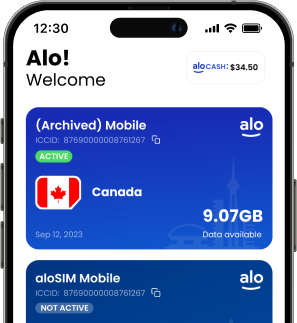If you’re confused about the difference between eSIM vs. physical SIM card, you’ve come to the right place. This is a jargon-free zone! A safe space without any techie talk.
Because, yeah, we get it. Everybody’s suddenly buzzing about something called „eSIM“ after the surprising Apple news that those pretty new iPhone 14s aren’t going to hold SIM cards anymore, and … and what does that mean, really?
Let’s start with the basics …
You have a phone. Awesome!
And you’ve probably seen a SIM card.
They’re those little plastic card thingys that go inside the phone. You don’t really ever see them, except maybe if you’ve switched from one cell phone provider to another, and they’ve stuck a paperclip into a tiny hole on your phone, and popped a little tray out of nowhere.
Inside your phone right now, there’s a SIM card. So what do those little plastic SIM cards *do* exactly? They’re the „guts“ of your phone that give it internet data. They tell your phone which network to connect to, and …
Nope, nope, nope. Too technical.
Let’s go even easier …

Think of a physical SIM card as a book
You walked into a bookstore. You bought a thick hardcover book, and now it belongs to you. You can flip it open and read it whenever you want, but the story is always going to be the same.
The pages of that book contain an awesome story — the story of your phone number, and how it runs on a specific network.
If you want to buy a different book (another SIM card), it will tell you a different story (connect you to a different network). But you can only read one book at a time, just most devices can usually use one SIM card at a time.
So if you lend your book to your friend (remove your SIM card from your phone), you don’t have it anymore. You can’t read that story (use that phone number) until you get it back.
But the trouble with a real book (or physical SIM card) is that it can get messed up.
You might drop it in the tub and make the pages all crinkly when they dry. You might drop it on the sidewalk and lose it for good. You might loan it to someone and never get it back.
Physical books (just like physical SIM cards) are real things that can be broken or lost.
Plus, if you want to buy a new hardcover book, you have to get in your car, go back to the bookstore, wander around the aisles until you find one you want, stand in line to pay for it, and then drive back home. Not exactly fast.

Think of an eSIM as an eReader
Lots of companies are making eReaders now, and you might have heard of a Kobo, a Kindle, or a Nook. If not, that’s okay. They’re just slim little computers that can hold hundreds of stories, so you can flip through them whenever you want.
So picture it: you have an eReader.
Your eReader makes it really easy to read LOTS of stories (connect to lots of networks) whenever you want.
You don’t have to visit the bookstore. You don’t have to order anything online and wait weeks for it to arrive. It’s INSTANT.
You want a new eBook (data for your phone), and you can buy it in seconds online. You can have lots of books at once, all loaded up on your eReader.
You can’t hurt these eBooks. There’s no risk of taking them out of the house and breaking them or losing them. They’re safely tucked inside your eReader, ready for you whenever you want them.
And your eReader can hold lots of them, all at once! Reading an eBook doesn’t affect the physical book you might have propped up on your nightstand, either. You can read an eBook (or use an eSIM data plan) at the same time as you’re reading a hardcover book (or using a physical SIM card).
And the nice thing about choosing eBooks (or eSIMs) is that they’re usually a lot cheaper than hardcover books (or physical SIM cards). You can also take advantage of online promotions and coupon codes.
The benefits of using an eSIM
How was the book analogy? Cool? Okay, good. We really want to make this super simple.
Let’s re-cap …
An eSIM is the digital version of a physical SIM card (plastic card thingy)
It works the same way, giving your phone data so you can play online games, check your email, go on social media apps, and chat with people.
Your phone can probably already use eSIM
It’s true! And maybe you had no idea, because it doesn’t say anywhere on your phone, but check our list of phones that can use eSIM and see if yours is on there.
You can’t mess up an eSIM
No need to poke a paperclip into that little pinhole on your phone, or take off your phone case, or mess around with anything inside your phone. If eSIM technology is *in there,* it’s in there permanently.
An eSIM can be purchased instantly online (no stores, no waiting)
No, you don’t need to visit that cell phone store in the mall by the pretzel place, or mess around with those sketchy SIM card kiosks in the airport. Shop online for eSIMs, safely.
It’s almost always cheaper to use an eSIM vs. a physical SIM card
Do your homework on this one, if you want, but many eSIM data packages cost as little as $5 for a week of data. (That means you could fly to France, pay $5 for an eSIM, and happily have internet on your phone for a whole week.)
You can use your regular phone number with an eSIM
Remember, if you yank out a physical SIM card, you’re also removing your phone number. But you can add and remove eSIMs whenever you want, and you’ll maintain access to your regular phone number. (This is super convenient for staying in touch with people while you’re traveling. They can call and text you on your regular phone number, just like always.)
An eSIM will save you from paying roaming charges
When you’re traveling, it’s easy to install a local eSIM for another country. Then you’ll be instantly connected to one of their networks, so your phone has data on your trip. Then you won’t need to pay your regular cell carrier any annoying roaming fees.
If you need more data, it’s easy to top up your eSIM
It’s super fast to add more data to an eSIM — think of it like throwing another $5 of gas in your tank. This is very different from using a physical SIM card, where it would run out and be completely useless.
Don’t be afraid of eSIM
We know change can be hard, especially when it comes to techie changes.
(Remember when TV remotes were easy to operate, and there was only one of them you had to learn? Now it seems to take three remotes and a prayer to get my Netflix up and running.)
Don’t let the eSIM vs. physical SIM card debate stress you out, because the shift is honestly an easy one. They work the same way — giving your phone data — except an eSIM is more convenient, faster, and cheaper than a physical SIM card.
And if you have any questions, the aloSIM team is always here to help!





